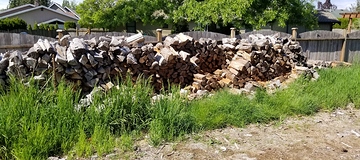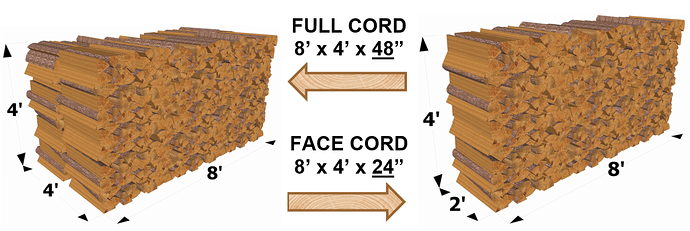Firewood is firewood right? WRONG!
Many places sell “seasoned” firewood – but the definition of seasoned firewood is debatable. Truly seasoned firewood needs to be aged for a minimum of twelve months, properly stacked for maximum airflow and preferably in a covered environment – not just split wood left to “season” in an open field.
So how do you know if you are getting properly seasoned firewood for cooking? You have to do a little bit of research when buying the wood. First, the wood should be light in weight. This means that all of the moisture content (water) in the wood is gone. Second, remove several pieces of bark from the wood. If the bark is still sticky with sap or you get a strong smell of sap coming from the wood, it’s not good firewood for cooking. It may be fine for your fireplace – but not for cooking. Third, split the wood with a small ax and inspect the inside. If the inside is considerably darker than the outside (minus the bark), that is a sign of moisture. Rub your fingers or thumb along the split wood then immediately rub your fingers together. If there is a hint of moisture, you should feel it.
There will be some smoke when burning firewood – obviously. Smoke is a good thing when you are using a smoker… but excessive smoke can be chalked up to improperly seasoned firewood. Remember, when the water in the wood is heated to 212°F / 100°C – it turns to steam and steam looks an awful lot like smoke.
When searching online for your closest firewood dealer, try to fine one that specializes in “Cooking Wood”. These specialty firewood dealers sell to restaurants that have inside wood-fired grills and inside or outside smokers. They also stock several types or “species” of firewood – usually in convenient-to-carry 2cf bags, but also by the pallet or truckload (F150 / Dodge Ram). For a cooking wood dealer example, here is a link to the cooking wood dealer we buy from in Seattle, CookingWoods.com. They offer many species of cooking wood and also offer smoking chips, but stay away from any firewood wrapped in wax paper – even if it is food grade. The wax can adhere to your hearth cooking surface.
Keep in mind, specialty cooking wood will be more expensive than locally cut and harvested firewood. So, to save some money, have two supplies of firewood when cooking. Your starting and heating fire should use the lower cost, locally harvested firewood, but when it comes time to cook meat, switch to the more aromatic and flavorful cooking wood.
Search for a Firewood Dealer near you on America’s LARGEST Firewood Directory - Firewood Near Me
–

